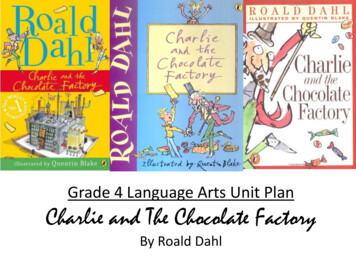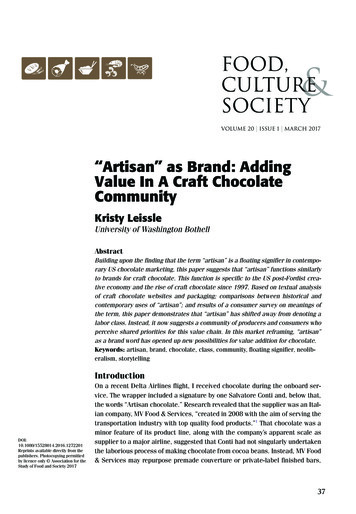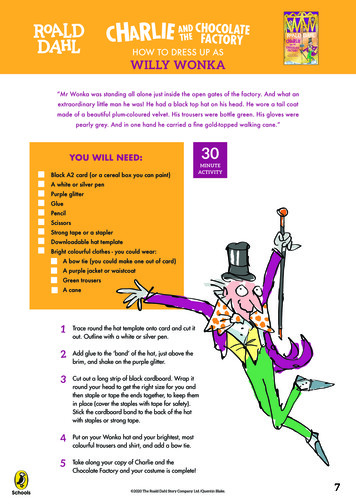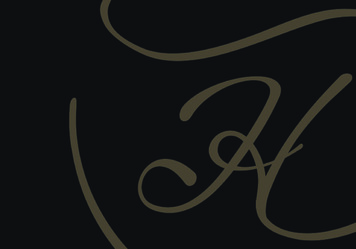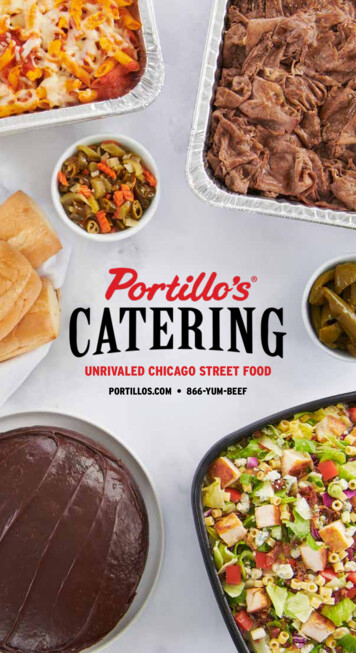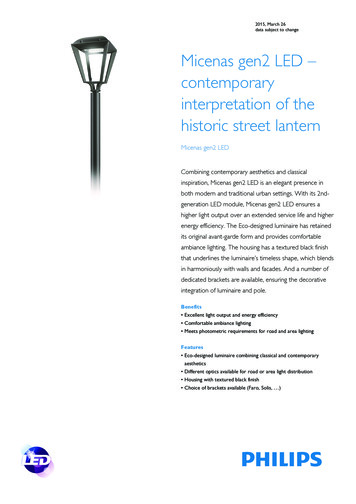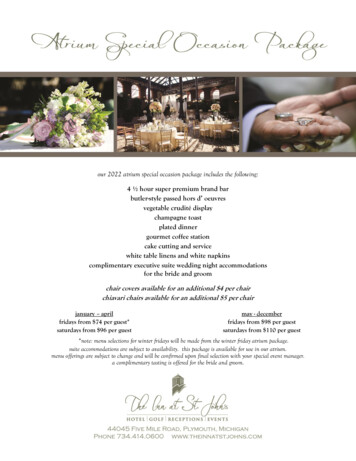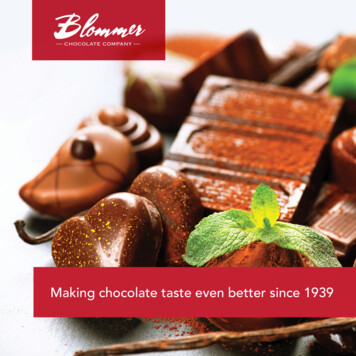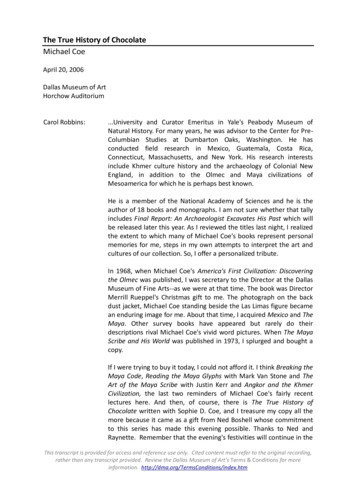
Transcription
The True History of ChocolateMichael CoeApril 20, 2006Dallas Museum of ArtHorchow AuditoriumCarol Robbins:.University and Curator Emeritus in Yale's Peabody Museum ofNatural History. For many years, he was advisor to the Center for PreColumbian Studies at Dumbarton Oaks, Washington. He hasconducted field research in Mexico, Guatemala, Costa Rica,Connecticut, Massachusetts, and New York. His research interestsinclude Khmer culture history and the archaeology of Colonial NewEngland, in addition to the Olmec and Maya civilizations ofMesoamerica for which he is perhaps best known.He is a member of the National Academy of Sciences and he is theauthor of 18 books and monographs. I am not sure whether that tallyincludes Final Report: An Archaeologist Excavates His Past which willbe released later this year. As I reviewed the titles last night, I realizedthe extent to which many of Michael Coe's books represent personalmemories for me, steps in my own attempts to interpret the art andcultures of our collection. So, I offer a personalized tribute.In 1968, when Michael Coe's America's First Civilization: Discoveringthe Olmec was published, I was secretary to the Director at the DallasMuseum of Fine Arts--as we were at that time. The book was DirectorMerrill Rueppel's Christmas gift to me. The photograph on the backdust jacket, Michael Coe standing beside the Las Limas figure becamean enduring image for me. About that time, I acquired Mexico and TheMaya. Other survey books have appeared but rarely do theirdescriptions rival Michael Coe's vivid word pictures. When The MayaScribe and His World was published in 1973, I splurged and bought acopy.If I were trying to buy it today, I could not afford it. I think Breaking theMaya Code, Reading the Maya Glyphs with Mark Van Stone and TheArt of the Maya Scribe with Justin Kerr and Angkor and the KhmerCivilization, the last two reminders of Michael Coe's fairly recentlectures here. And then, of course, there is The True History ofChocolate written with Sophie D. Coe, and I treasure my copy all themore because it came as a gift from Ned Boshell whose commitmentto this series has made this evening possible. Thanks to Ned andRaynette. Remember that the evening's festivities will continue in theThis transcript is provided for access and reference use only. Cited content must refer to the original recording,rather than any transcript provided. Review the Dallas Museum of Art’s Terms & Conditions for moreinformation. http://dma.org/TermsConditions/index.htm
TrueHistoryChocolate 01 PUBLIC.mp3restaurant immediately after the lecture. Josh Rose has asked that Iremind you, walk up the concourse and present your blue slips to bewelcomed for the book signing and the chocolate tasting. My personalthanks to Michael Coe, we are privileged to have you with us againtonight.Michael Coe:Thank you, Carol. It is a pleasure to be back here once more talkingupon a completely different subject than what I talked about last timewhich was, of course, the Khmer and Angkor Wat and the great city ofAngkor.How I got into this business about chocolate It's sort of amazing tome that I am considered a great chocolate expert by people who don'tknow much about chocolate greatly. Sometimes I feel like a jack of alltrades and master of none. How I really got into this was through mylate wife, Sophie, who was in the last decades of her life, a foodhistorian, an anthropological food historian studying the cuisines of anew world. She wrote this book called America's First Civilizationwhich the UT Press here published. It's has been a very successfulbook.When she covered Mexico and Central America and that, andparticularly the Maya and Aztec, she felt that she had not done realjustice to the subject of chocolate and she began to research it. Andshe researched it for about two years, decided she was going to writea book that dispelled a lot of the absolutely ridiculous stuff that havebeen written and still is written, I am sorry to say, on the history ofchocolate.There is more mythology about this that appears on the internet thanyou can possibly imagine. There is hardly an internet site that isn'tmade out of whole cloth on this subject. They’ll tell you thatColumbus took the chocolate bean back to Spain, that's why we alldrink chocolate and so forth. Columbus didn't. He saw chocolatebeans but he didn't have the farthest idea what they were. Here is aguy who thought that it was off the coast of China after all. He neversaw a chocolate being used and it goes on and on and on. It's reallydepressing.(00:04:58)So, she decided to write a book called the True History of Chocolateand unfortunately, she only got a couple of chapters done. She had allthe research done. She never lived to see it and I promised that Iwould finish it and it was a real pleasure to do this. I took all of hernotes to Italy, to Rome, which is a place where I like to write books,and stayed there until I had written it. So, in a way, this is her bookDallas Museum of ArtPage 2 of 18
TrueHistoryChocolate 01 PUBLIC.mp3and that's why she is senior author. She thought the whole thing up inthe first place.It needs a new edition I will have to admit because there is a lot ofrecent stuff that's been done on that. And it's a story that is incrediblyimportant, we now know from Mesoamerica, from the people ofMexico and Central America, particularly the Maya. In their culture,we now know, from the earliest times on, right through the Spanishconquest and even until today, the consumption of chocolate andparticularly the chocolate drink was enormously important.So, we will talk about the tree. Where does chocolate come from?Years and years ago, René F. Millon, a very distinguished archaeologistwho, when he was a graduate student at Columbia, wrote adissertation called When Money Grew on Trees--a wonderful titlebecause the chocolate bean, the beans of the cacao tree, were usedas currency in Aztec times and also among the Maya at the time of theconquest. Now, I am not going to talk about that tonight; I am goingto talk about chocolate as a drink and as food.It's a tree called Theobroma Cacao: Theobroma, meaning food of thegods in Greek, and Cacao, C-A-C-A-O, being the real name ofchocolate. Where the word chocolate came from is a very complexsubject and I am not even going to go into that here. Most of whatpeople say about the name and where it derives is again mythology.We really don't know.The real name of chocolate is cacao and the tree is the cacao tree andthe cacao tree is an understory tree. It grows in the tropical forestsbut underneath a canopy of higher trees and it doesn't look like much;it's sort of sprawling and squiggly looking thing. It's a kind of thing thatyou certainly wouldn't plant in your back lawn as an ornamentalbecause it's not a very good looking tree. It produces flowers all overthe trunk and on the larger branches these tiny little flowers, I won'tsay they are as small as a pinhead but they are certainly no biggerthan a tack and they’re little, white, purplish-white flowers andthousands of them on the trunk. A few of these get themselvespollinated properly by midges, that's what pollinates the tree.Eventually, you will have on the tree sprouting out from it these podswhich contain the seeds of the tree. These are the cacao pods.Now, they are really tough on the outside. This tree cannot in the wildreally disperse its seeds on its own. So, monkeys in the wild--andpeople aren’t around--monkeys and parrots, large birds like parrotswith tough beaks will tear these pods of flower and consume them.This is from a classic Maya plate out in California, I believe on show inSan Francisco at the brand new de Young Museum there and shows aDallas Museum of ArtPage 3 of 18
TrueHistoryChocolate 01 PUBLIC.mp3spider monkey running along with cacao pods. Now, why would wildanimals go in the first place for these pods? If you cut these pods, theright pods open, which are sort of like the size of a small tiny football,you will find inside the seeds covered with a delicious white pulp. Itreally is good.So, there is this gooey pulp. This is my friend [inaudible] in Bali of allplaces opening up one of these things because cacao is now grown inthe tropics of the world, all around the world, particularly in Africaand in Indonesia, places where it was taken after the conquests of theNew World and during the colonial period. It's a tropical tree; itcannot tolerate frost or anything like that. So, it's only in the tropics.So, if you open it up, you will find it looks like this. It doesn't lookchocolate at all; the seeds are inside that pulp. Then as I said, the pulpis delicious and that's what the animals are after and probably whatearly humans were after, when they first got interested in this tree.So, then what do you do? What's the process to turning this intochocolate and who did it?(00:10:01)This is really rather a mystery because it's a rather complicatedprocess. It has five important steps to it once you cut these pods offthe tree. The first is to open them up with, let's say, today with amachete and then dumping the insides out into a tray or a vat oranything like that and letting them ferment probably for usuallysomething less than a week; five days or something like that and itbuilds up heat. The heat kills the seed that's inside there. It doesn'tgerminate any further which is important and the pulp runs off asalcohol or let's say mild alcohol that is sort of a wine as the sugar isturned into alcohol leaving the seed itself.You can actually drink this wine; it's got a bit of a kick and I amsurprised that people haven't taken more advantage of this because itis rather good. So, at any rate, but they had other things to makehooch out of, so don't worry. So, they ferment it, that's the first part ofthe process.The second thing is then you have the seeds which are wet from thefermentation process, you have to dry them and this is in Belize dryingthem in the sun, just laying out a piece of canvas and let these thingsdry. So, fermentation, drying the seeds. The seeds are bitter; theanimals and early humans were not interested in the seeds becausethey contain bitter alkaloids, I will talk about those later, but you haveto dry them. So, that's the next part of the process.Dallas Museum of ArtPage 4 of 18
TrueHistoryChocolate 01 PUBLIC.mp3Then you have to roast them. Until you roast these seeds, they don'ttaste at all like chocolate, not the slightest bit, I mean barely. You takejust the dry cacao seed and get a little taste of chocolate but notmuch. It is not until you start roasting it that the full chocolate flavorstarts coming out. The chemistry involved in this is enormouslycomplex because there’s hundreds of compounds in the seeds ofchocolate, so called beans. Then you have to winnow them becausethere is a sort of skin on the outside of these seeds and you have toget rid of that, that's a winnowing process. So, that's the third part ofthe step that has to be gone through.Then they have to be ground and the native way of doing this inMesoamerica, which is where this chocolate was invented in the firstplace of this process, is to grind it with a mano and metate. The sameway as the housewife grinds the soaked corn, the corn that's beensoaked in lime to make the dough for tortillas and tamales. The sameprocess is closely related to it, but they apply heat underneath to it toreally bring up the flavors of the bean. So, they take the same manosand metates, they heat them up, and she will grind this stuff into thesolid chocolate mass.So, those are the steps; fermentation, drying, roasting, winnowing,and grinding, and whether it's a local producer and his wife in a littleplace down in Southern Veracruz or in Belize or anywhere, the processis exactly the same as it would be in this way in the great big chocolateproducing multi-national firms today; Nestlé, Hershey’s or Cadbury’sor any of those people. The process is the same everywhere, it's justthe machinery is different. That's all.What you end up with as you can see here, I'll get my laser light, thoseare the dried beans now. There is the pod, the original pod, and thenit's ground and they make a cake out of it, a dried cake. Now, that'ssolid chocolate without any question and that is turned into a drinkusually drunk in a gourd and I will show you Mayas doing exactly that.It's flavored and one of the favorite flavors is vanilla, which is again aMesoamerican domesticate that was rather complicated production.It's actually an arboreal orchid that grows in Veracruz originally. It'sbeen taken all over the tropics in the world now, particularly inMadagascar.But it has to be fermented in a very special way-- very difficult to getthe plant to germinate and all of these things, so at any rate. Butvanilla was a favorite flavoring for the Mesoamerican peoples. So waschili pepper and many other flavorings were added to it. Certainflowers of certain trees and the sweetener was probably, if they usedit at all, which they did from time to time, was either native honeymade from the native stingless bees or else made from the expressedDallas Museum of ArtPage 5 of 18
TrueHistoryChocolate 01 PUBLIC.mp3juice from the stalks of maize.(00:15:09)Now, where did this take place, this mysterious invention? We don'tknow for 100% but it had to have been in Mesoamerica. It had to havebeen in the lowlands. There is some evidence and so far it's entirelycircumstantial that the Olmec area here on the northern side of theIsthmus of Tehuantepec in southeast in Veracruz, state of Veracruz, iswhere this happened among the Olmec. You have seen beautifulOlmec pieces in this exhibit here and in the permanent collection ofthis museum. This was the first great civilization of Mesoamerica and Idon't care what anybody else says, history will absolve me. This is themother culture of all other Mesoamerican cultures. This is the firstgreat civilization, equivalent to what Greece and Rome were forEurope throughout European history. One that people never forgot.And I am positive, -- well, I won't say, positive but I will be willing tobet we are going to find evidence that the Olmec were the first onesto do with this. The reasoning is that the word 'cacao' is found inpractically all Mesoamerican languages for chocolate. The word'cacao' actually is a lone word in those other languages. It reallyoriginates in a language that was spoken in Olmec country, we calledMixe-Zoque. I am almost certain that was the Olmec who did this but Iwould say, the proof is going to come shortly because they are nowanalyzing Olmec pottery to find traces of chocolate in them. The workhas just started.If you don't know anything about the Olmec, you should learn--theyare great civilizations. They are famous for their colossal heads andthese are really early. They were making colossal heads like thistremendous huge vessel monuments of stone brought in from 75 or100 miles away on rafts at the time when the poor old Maya didn'teven know how to make pottery. It's an incredible civilization, I meanreally exciting, wonderful artists. The first great city of the New Worldwas built by these people at San Lorenzo in Southern Veracruz. So, I’mattributing the invention of chocolate to them because I think they didit, but I can't prove it yet.The first really hard evidence for who might have had early chocolatecomes from the Maya area though and it is hard evidence. This is thesite of Río Azul in northeastern Guatemala, very near the Belizeborder. This is an old Guatemalan map so it doesn't show Belize as acountry, but it is. That's Belize right there. It's right near the Belizeborder.At Río Azul an expedition worked on tombs at Río Azul, and found-Dallas Museum of ArtPage 6 of 18
TrueHistoryChocolate 01 PUBLIC.mp3this is a great Maya pyramid probably about 450 A.D. and the king,who had just died, is being buried here in a tomb dug down into thebedrock containing early classic Maya pottery. This is the remains ofone of these rulers of these kings. Everything organic is gone becausethis is the tropics. This is way deep in, the hieroglyphs written up hereand then various pottery vessels around here. Some of themcontaining animal bones, fish bones and so forth but the cylindricalones were something else, the taller ones.One of these turned out to be really important at Río Azul. This is nowfamous, you even get this on the Hershey company website. This is ascrew-top jar sitting on a pot stand here. It's early classic about 450A.D. during the early classic. This top screw is on and off like the top ofthe Mason jar and it's got hieroglyphs around it on stucco, created onstucco.Now, we can read these hieroglyphs now. 25, 30, 40, years ago, wecouldn't do this. I mean, I have been talking through my hat if I weretrying to tell you what these hieroglyphs said. We now know whatthey say. David Stuart here, in the lower left, who is now full professor,named professor at University of Texas in Austin, he started studyinghieroglyphs when he was eight years old. By the time he was eleven,he gave his first public lecture on the subject and he got a MacArthurFellowship eventually, the youngest person to ever get one. I meanthe guy is a genius.(00:20:10)He found out how to read this hieroglyph here. Here it is and it is to beread as ka. This is written phonetically now and this is also ka here,just another way of writing this. It's a fish and this is a fish fin here. So,it's ka ka and this sign down here is wa, but the final vowel is notpronounced when you are -- this is a syllabary and we are reading thisas syllable. It's cacao. So he said, this thing might have chocolate in it.This is a vessel for chocolate, which is exactly what this inscription tellsyou and it tells you who the king is who owned it.Well, they send this vessel along with several others that had a kind ofresidue on the bottom to the Hershey company lab in Hershey,Pennsylvania and lo and behold, they found two alkaloids there. Thesealkaloids are well known because they are the two alkaloids that occurtogether and are peculiar to chocolate. They are caffeine, which youare quite familiar with, a stimulant, a diuretic, as you know it makesyou go quickly to the bathroom and theobromine, which is the milderstimulant and diuretic. The theobromine is peculiar to chocolate. So,QED but with chocolate residue. They’ve now gone and found this in alot of Maya vessels.Dallas Museum of ArtPage 7 of 18
TrueHistoryChocolate 01 PUBLIC.mp3That famous vessel that's upstairs, that cylindrical piece that shows asacrifice taking place, it's a wonderful late classic Maya vase thatcontained chocolate at one point. Every single Maya cylindrical vasethat we know of like that contained chocolate because it says so onthe hieroglyphic inscription along the rim.Well, they found it even earlier in the Maya area. This again isUniversity of Texas. Texas does all these things. Here is the site ofColha in Belize, which the University of Texas has been digging foryears. At 600 B.C., which we called the middle pre-class or middleformative period, I mean long, long before, thousand years before thatRío Azul, they analyzed a number of these vessels and found insidethem chocolate--that is theobromine and caffeine residues. Whatwere the spouts for? Well, we know think that those spouts wereborrowing the chocolate air into it and making a froth on the top and Iwill show you about that later on.We have many descriptive pictures of these indications of thesepeople drinking chocolate on pictorial Maya vases, most all of whichcome from the late classic, although, all through the early classic, thatis through the whole span from 300 A.D. through the time when thecivilization disappears by 900 A.D., they are drinking a lot of chocolateat all important occasions.This is actually a roll out done by my friend Justin Kerr in New York. Heis a New York photographer and a great student of Maya art and soforth. He invented this roll out camera. So you can take a cylindricalvase and then roll it out so you could see it as a mural and really studyit. So, this is the Justin Kerr roll out and it shows a ruler seated on histhrone. This is probably around 700 A.D. and here are theseunderlings, both with the same costume, who are bringing in offeringsto him probably tribute from another important politician and theyhave brought in chocolate for him to drink. On the top of here there isfroth. Now, how do we know that it's chocolate? Because thathieroglyph over there is the same glyph, believe it or not, that was onthe Río Azul screw-top vase.So, he is drinking chocolate and down here is what he is going to eat.They brought him some nice tamales covered with sauce here andcertainly those are corn tamales there. So we have many scenes ofthis and we know that chocolate was used not only to bring in to sortof butter-up important kings and politicians, but also probably to sealmarriage negotiations. Still important today in the Maya area,chocolate during marriage negotiations and during marriageceremonies. Probably sent in quantity of the chocolate beans topeople and to important kings as tribute.Dallas Museum of ArtPage 8 of 18
TrueHistoryChocolate 01 PUBLIC.mp3(00:25:03)We have that on the Bonampak murals. We understand now, hugesacks of chocolate beans brought in.Probably, it had the role in this culture that Champagne does with us.That is it is something that you crack open. Even if you cannot affordit, by God, you got to have Champagne for your daughter's wedding.It's not something that's used as kind of everyday by everybody; it'svery much a status and elite thing.Now, probably at the same time, it was money; it was valuable. It wasused as a small change in negotiating in marketplaces. So, it already,chocolate had tremendous value, but it was always a drink. For thefirst couple of thousand years of its existence, it was a drink, not asolid chocolate bar at all.There was even a chocolate god, who was actually a form of the MaizeGod.This is a carved vase from Dumbarton Oaks. It's actually a carved stonevase, of bone from Dumbarton Oaks in Washington probably againabout 450 A.D., the same time as Río Azul, those burials there and itshows the Maize God seated on his little throne here. His name ishere, it tells you what's his portrait and this guy is popping off cacaopods all over his body. So, the Maize God, very important, central godin Maya thought and religion all the way back to the Olmecs, was alsothe god of cacao, of chocolate. You have many representations of theMaize God in different periods and different places in the Maya area.This is in the Popol Vuh Museum in Guatemala City and it's awonderful one from the Pacific coast of Guatemala showing what isprobably the Maize God or a Goddess of some sort with cacao podspopping out all over the place. These look so realistic that they couldhave even been cast from actual molds of real cacao pods.When you reach into later times, people like the Mixtecs, Zapotecsand so forth, we know from the codices that they made and things likethat, they also took a lot of cacao and very important in marriagenegotiations and things of this sort, big chocolate drinkers. They likethe froth of the top, we know that from Aztec accounts that the froththat you got up was extremely important. Now, from colonial timeson, you have a swizzle stick to do this. My wife and I were convincedand I am still convinced that this was introduced by the Spaniards. Thenative way of making that froth was to pour as in this scene for earlycolonial times, an Aztec woman pouring from a great height, from onevase into another to make this froth on the top.Dallas Museum of ArtPage 9 of 18
TrueHistoryChocolate 01 PUBLIC.mp3Here is from a Maya vase, now in Princeton, late classic, some 750A.D., much earlier than this. She is pouring it from a great, greatheight in the palace of an underworld god--beautiful scene here. Thefroth of that was like the bubbles in Champagne; you wouldn't want todrink flat Champagne, they didn't want to drink chocolate without thelovely froth on top which they spooned off with tortoise shell or bonespoons very, very carefully. That was the first thing they went for.Now, when the Aztecs got into Central Mexico, they came insomewhere from the northwest, we really don't know exactly fromwhere. They came in as semi-Barbarians. They never heard ofchocolate in their lives. They got in there, they found in the oldercivilizations around the valley of Mexico, where Mexico City is today,they found people drinking and highly valuing chocolate. They wantedto do it too, but they had to import it, they had to get theirs from thetropics, from the Maya area and places like that, which they did. Thisis a great, a high ranking Aztec ruler in a wonderful early Colonialcodex showing the splendor of these people. So, they quickly becamecivilized. And among the Aztecs, we have lots of documents on this,lots of information from Father Sahagún and other early chroniclers.It was a completely elite drink. The king, the court, the nobles, theycould drink it. The highest ranking priests, the highest ranking officersof the army could drink it, but it was very restricted; you had to be aproven warrior to drink it. For everybody else, they weren't allowed tohave due to sumptuary laws. The same thing was true all throughMesoamerica; among the ancient Maya and probably among theOlmec, who almost certainly invented it. So, it was quite a differentthing.(00:30:07)This is downtown Tenochtitlan, now of course underneath MexicoCity, although today you can see at least part of that great temple tothe Rain God and to the God of War, Huitzilopochtli. The Aztecs knewthat the best chocolate came not from down on the coast of Veracruzor over in Chiapas, but down here in the province of Shoconochcocalled Soconusco in Colonial times. Down in Chiapas and going overinto the Pacific coast of Guatemala, this was the top quality cacaofrom one particular variety of cacao which among chocolate producestoday is called criollo. Today the best and finest chocolate originateshere.So to get it, they sent their armies down and they took this provinceover, even though it was nowhere as near the rest of the Aztec Empireand they kept that. It was extremely important to them, they had tohave that and when the Spaniards conquered the Aztecs andDallas Museum of ArtPage 10 of 18
TrueHistoryChocolate 01 PUBLIC.mp3eventually picked up chocolate drinking, they wanted this stuff too.This is the kind of chocolate that arrived at the Spanish court, it wascriollo chocolate. And even today among chocolate producers,chocolate that is largely criollo chocolate is still the best.We have many descriptions from the Spaniards of chocolate drinkingamong the elite and the royal court from Bernal Diaz del Castillo, awonderful description of the emperor Motecuhzoma taking hischocolate. This is a wonderful illustration done by a graphic artist backin the 1920s for a book on the Aztecs illustrating Aztec life, and it'sreally good, it's really accurate. That's exactly what he really lookedlike, the emperor drinking his chocolate, because that artist has himspooning off the froth on the top of it.Today, well, if you live in the north and go skating in the outdoors, youwant to drink hot chocolate. It's really lousy what they give you, butthey squirt a lot, they used to squirt a lot of whipped cream on thetop. Now it comes out of a spray can, but it's the same idea, only hereit was pure chocolate.So the Aztecs had it and many, many descriptions. So important wasthe bean, the Cacao bean, that the emperor had huge storehouses ofchocolate beans which were sort of like Fort Knox is to us. Absolutelytremendous bins of this stuff that he paid people with, paid his army,gave his army to take out and so forth. It was so valuable to the Aztecsthat there were even chocolate counterfeiters who could counterfeitthese beans.Later on when the Spaniards came they began to counterfeit Spanishgold money. They were very, very good at this.Well, okay, so how does it get to Europe? Well, the story is thatChristopher Columbus brought it. That story is complete rot, I mean,totally made up. People who write this stuff, on the Internetespecially, think that nothing is known about the Aztec, I can writewhatever I want about it and they sure do. I can tell that's ridiculous.Columbus, on his fourth voyage off of the coast of Honduras--thenorth coast of Honduras, the island of Guanaga in 1502, according tothe account from his son, Ferdinand--captured a great Maya tradingcanoe, huge thing. I mean, it was as long as this auditorium and in themiddle of it was this great big fat trader and his slaves and his wivesand everybody else and he had these strange beans that the Spaniardsthought were sort of like almonds. They didn't know what they were.They were amazed and when anyone of these were dropped to thebottom of this great trading dugout, they snatched it up as though oneof their own eyes had fallen out of their head. But he hadn’t any ideaDallas Museum of ArtPage 11 of 18
TrueHistoryChocolate 01 PUBLIC.mp3of what it was because he never got to the mainland of Mesoamerica.He never saw a chocolate being used, hadn’t the foggiest idea of whatit was. So that's one myth that has to be dispelled.So who did take it? Well, other of these stupid internet sites tell youthat Hernán Cortés took it. Well, we know a lot about what HernánCortés took back to Spain because it was all inventoried andeverything and there isn't one mention of a chocolate bean in any ofthose documents. So who did take it?(0034:49)Well, the earliest that my wife and I could find, actually Sophie wasthe one who found it, was a Dominican document where a Dominicanpriest took-- they were in the Alta Vera Paz of Guatemala among theK'ekchi Maya and they took a group of K'ekchi nobles, high rankingon
spider monkey running along with cacao pods. Now, why would wild animals go in the first place for these pods? If you cut these pods, the right pods open, which are sort of like the size of a small tiny football, you will find inside the seeds covered with a delicious white pulp. It really is good. So, there is this gooey pulp.


